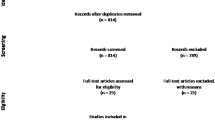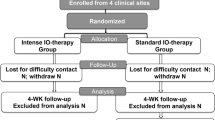Abstract
Purpose
To identify the variation within and consistency amongst orthoptists when prescribing occlusion therapy for amblyopia in an objective survey.
Methods
A questionnaire was designed with five case examples of amblyopic children and distributed at annual meetings of orthoptists in the Netherlands and Germany. It was filled in simultaneously within 15 min in complete silence to avoid any exchange of opinions between orthoptists that would reduce variability. For each case the orthoptists were asked to give their prescription of hours or days of occlusion.
Results
The questionnaire was filled in by 177 Dutch orthoptists and 227 German orthoptists. Their prescriptions of occlusion therapy were classified into five main regimens: part-time; part-time not every day; full-time; also occluding the amblyopic eye; alternating; and no occlusion therapy. The variation was large: the standard deviation was half the average prescribed hours of occlusion for each regimen in each of the five cases. All orthoptists were assigned a rank number for each of the five cases depending on whether their prescription was above or below average. These five rank numbers were not consistently above or consistently below average value per case.
Conclusions
The number of prescribed hours of occlusion varied widely per regimen per case. Orthoptists were not consistently strict or lenient in their prescription of occlusion therapy.

Similar content being viewed by others
References
Allen J (1730) Synopsis universae medicinae practicae. Westenius, Amsterdam
Buffon de M (1743) Dissertation sur la cause de strabisme on des yeux louches. Mem Acad R Sci Paris
Haase W (1995) Amblyopie. In: Kaufmann H (ed) Strabismus, 2nd edn. Enke, Stuttgart, pp283–395
Javal E (1896) Manuel théoretique et practique du strabisme. Masson, Paris, pp 91–97
Loudon SE, Polling JR, Simonsz HJ (2003) Electronically measured compliance with occlusion therapy for amblyopia is related to visual acuity increase. Graefes Arch Clin Exp Ophthalmol 241:176–180
Mein J, Trimble R (1991) Diagnosis and management of ocular motility disorders, 2nd edn. Blackwell Scientific, Oxford
Saint-Yves de C (1722) Des yeux louches: Nouveau-traité de maladies des yeux. Pierre-Augustin le Mercier, Paris, pp 118–123
Stewart CE, Fielder AR, Stephens DA, Moseley MJ (2002) Design of the Monitored Occlusion Treatment of Amblyopia Study (MOTAS). Br J Ophthalmol 86:915–919
Tan JHY, Thompson JR, Gottlob I (2003) Differences in the management of amblyopia between European countries. Br J Ophthalmol 87:291–296
Von Noorden GK, Campos EC (2002) Principles of nonsurgical treatment, 6th edn. Mosby, St. Louis, pp 537–558
Worth C (1901) Squint: its causes, pathology and treatment. John Bale, Sons & Danielsson, London
Acknowledgements
We thank the 404 orthoptists for their hospitality and for filling in the questionnaire. We acknowledge René Eijkemans and Caspar Looman for their help with the statistical analysis.
Author information
Authors and Affiliations
Corresponding author
Rights and permissions
About this article
Cite this article
Loudon, S.E., Polling, JR., Simonsz, B. et al. Objective survey of the prescription of occlusion therapy for amblyopia. Graefe's Arch Clin Exp Ophthalmol 242, 736–740 (2004). https://doi.org/10.1007/s00417-004-0896-9
Received:
Revised:
Accepted:
Published:
Issue Date:
DOI: https://doi.org/10.1007/s00417-004-0896-9




